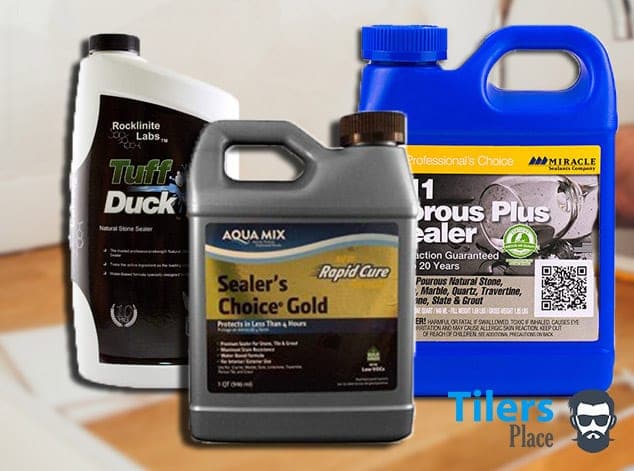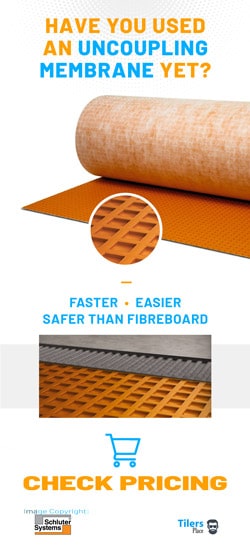Table Of Contents
Grout Sealer Ultimate Guide – All Grout Sealer Questions Answered By A Professional Tiler
Grout sealers – oh boy. If there was one thing that I get asked about the most on Tilers Place and in my professional life, it’d be about grout sealers.
Do I need one? When should I apply it? Will my grout be ruined if I don’t apply a grout sealant? Which brand do you recommend? Can I do it myself?
Those are the most common sealer questions but anyone that knows me knows that I beat a subject to death and try to pass on as much of my knowledge as possible.
Hence this article.
I took a poll and noted down all the questions my clients ask me about grout sealers and dumped them into one massive article.
Here it is folks, the ultimate article on grout sealers written by an actual tiler. Not by DIY “Experts”, house flippers or content contributors that installed a grout sealer once in their parent’s condo that one summer. This ones real.
What Is Grout?
To understand the mythical substance we know as a grout sealer, we first need to get a handle on what this grout stuff is.
In layman’s terms, grout is a hard substance that surrounds tiles. It’s a key component of a tile installation as it adds strength to the overall surface, adds decoration and prevents filth from building up in the gaps between tiles.
The most common type of grout is sanded which simply means that it has sand in it and is a key component that gives it it’s strength, especially in large gaps over 3mm. Throw in some color pigments, cement and some chemicals and you got grout. Easy.
Read this article to learn more about grout.
Unfortunately a substance made predominately of sand is bound to be porous.
Porous = water gets in.
When water gets in, it creates the ideal home for fungi, mold and your in-laws to live inside and ontop of the grout. We don’t want that.
Can you tile without grout lines?
No.
Tiles move and expand.
Plus they look horrible when butted up against each other. Some cool guys say you can tile without grout lines but they don’t make a living out of laying tile nor do they warranty their work for 10+ years. Don’t listen to the internet cool guys.
How long does grout take to dry?
Grout is used to fill the lines around tiles to add detail, strength and prevent dirt getting trapped inside. In order for it to perform its charm, it should be left to dry for a fair period of time; otherwise, it may not achieve proper strength and color uniformity.
On average, it takes between 24-72 hours to dry. However, multiple factors play a part in deciding how long it takes to dry. Below are some reasons and why it is so important to keep your grout dry and debris free while it cures.
Factors that Affect Drying Time
Grout Type Used
The question: “How long does Grout take to dry?” is not one that can be answered with a single number as different grout types cure differently. If you are unsure of what kind of grout was used, you must review the packaging as it provides specific details to its composition.
Here are some common tile grouts and how long it may take them to dry.
Cementious Grout
This type of grout is typically used in residential ventures. It is a sand-like texture that has to be mixed with water. It cures like basic concrete with it binding together slowly whilst the excess moisture in the mixture evaporates or gets absorbed. The cement grout will take 72 hours to dry properly.
Epoxy Grout
This type is used in both residential and commercial applications. Usually comes in two or three parts that are mixed together to create a workable product. A hardener liquid, solid paste and colorant (if the solid paste isn’t colored already.)
It’s a lot tougher to work with and it’s very costly. However, its very robust and works efficiently. Epoxy grout is immune to stains, grease, and temperature changes, which ensures it lasts longer than regular grouts. Unlike those grouts, this type does not need to be sealed, so this epoxy cavity takes about 24 hours to dry. The curing process is purely chemical reactions as there’s no water to evaporate.
Furan Grout
This one is very rare and most tilers won’t have worked with it as its only used in the industrial sector. Furan Grout is widely used for industrial applications due to its outstanding resistance to chemicals. Industrial uses include food & beverage plants, laboratories, dairies, textile, steel and pulp & paper mills.
It is very similar to the epoxy in that it comes in two parts and has unrivalled toughness and resistance. Its made to withstand a wide range of acids, alkalis and most solvents and can withstand temperatures upto 450°F. However, unlike epoxy grout, furan grout is made of reinforced alcohol polymers. The estimated drying time for this grout is normally 24 hours.
Room Humidity Levels
The humidity level of the room also influence the drying time of the grout. The amount of humidity in each room of a home is different. For example, because of the moisture, the bathroom is more humid. As a result, it can take longer to dry here than in the kitchen.
When it comes to various conditions, it also takes longer to dry in tropical climates than in dry climates.
The presence of plants in the room can also have an effect on the drying time of the grout, as they leave moisture in the room. Therefore, in areas where there are trees, the grout can take longer to dry.
Type Of Tile Used
The tile used in your installation will greatly affect the curing time, it’s the biggest factor in curing time of cementitious grout.
Porcelain tile is vitrified and will basically absorb no water into itself whilst a ceramic tile isn’t treated to the same temperatures and will readily absorb water. When grouting a ceramic tile its recommended to wet the tile beforehand to prevent it from sucking the water out of the grout and preventing it from achieving its full strength.
What’s A Grout Sealer?
Congratulations, you know what grout is, time to look at what is a grout sealer.
A grout sealer is a liquid chemical that uses water as a carrier of “solids”. These solids are the thing that prevents water entering tile grout. The idea is that the water enters the grout and evaporates, while the solids remain, create a barrier and protect the grout.
Imagine the water as being a troop carrier taking soldiers to the battlefield. They drop off their boys and go back to base whilst the soldiers (solids) do the real work.
What do these soldiers do exactly?
Create a frontline that repels mold, mildew, fungi and stains from attaching themselves to your grout lines. Anywhere that moisture is present, these nasty critters can be found. Showers, kitchens, swimming pool areas, etc.
In other words, a grout sealer will seal up the voids in the porous cement grout, leaving no place for water to enter. There’s plenty of great reasons to use one, read my article on the benefits.
Does An Expensive Grout Sealer Mean It’s Better?
Yes, because your paying for the added solids that come with higher priced products.
There are many brands of sealants and their price varies greatly from cheap homeowner products to professional strength solutions.
The price difference is dependant on the amount of solids inside the solution. A professional product like Aqua Mix Sealer’s Choice Gold is much more concentrated over it’s DIY counterpart Aqua Mix Penetrating Sealer. (Read my review here.)
What this means for you is that less coats are required to proper coat the surface. That’ll mean less work and a higher yield from the product. So whilst you pay more, you’ll be doing less work and spending less time on the task. Plus you get the assurance the job will be done properly, something that professional’s require as their staking their reputation on it.
Professional grout sealers also carry additional benefits depending on the brand like quicker drying times, added mold inhibitors, and longer warranty times. 10 years vs 5 in some instances.
DIY sealants are much more diluted and don’t have as many solids in them. Meaning a weaker solution that needs at least 3 coats to work effectively. Weaker ones will also need to be reapplied more often.
Weight up the pros and cons and vote with your wallet.
Is A Grout Sealer Essential?
Here’s something you won’t hear from DIY Experts, a grout sealer is not essential. I personally don’t use it in my home and I have tile EVERYWHERE: the garage, bedrooms, living areas, bathrooms, love dungeon.
If you are diligent with your cleaning and respect your investment, then a grout sealer is not essential to use. I’ve seen my installations after 10 years and they look as good as the day I applied the final bead of silicone.
Why?
Because my clients regularly cleaned their tiles, made sure to wipe up any stains or standing water and generally kept a tidy home. This prevented mold and mildew from getting a foothold in the grout and presto, a beautiful installation for years.
I understand not everyone has the time or patience to stay on top of cleaning. In that instance, a grout sealant is great insurance for those times when you can’t afford the time to clean thoroughly.
Additionally, it’ll help keep grout lines stain free.
Does Epoxy Grout Need A Grout Sealer?
Epoxy grout is a different beast entirely to cement grouts and does not require sealing ever. It’s virtually waterproof and does the job of a sealant without ever needing to apply one. Epoxy grout is the ultimate grout and is basically maintenance free, very hard wearing and perfect for high stress situations like commercial kitchens and showers.
Since its waterproof, no sealer will penetrate it and will wash off very quickly. If you have epoxy, don’t ever worry about grout sealing.
Now I bet you’re wondering why doesn’t everyone use epoxy grout if its so good? Well epoxy grout is very expensive and difficult to work with. A professional will charge a premium to install and supply it. Expect a bill at least 3x more if you opt for epoxy.
It’s important to weight the factors of using an epoxy vs sealing and whether the pros are enough to justify the price.
A shower that gets used a lot or you have high water pressure fittings installed may be a prime candidate for epoxy grout as you won’t need to worry about reapplying a sealant every 6 months. It’ll also prevent the grout from being washed out as cement grout can wash out over time due to high water flow.
Talk to your local tiler about both options before committing. Don’t set your heart on a solution before you speak with them either. Sometimes its not possible to use one product or the other depending on your tile choice.
Is It Easy To Use A Grout Sealant?
Despite the large amount of confusion surrounding this tiling product, a grout sealer is actually very easy to use.
If you follow the instructions on the label, you shouldn’t have any trouble using one and achieving the desired effect.
Large tile installations will take time however due to simple logistics. You need to go over every inch of tile grout and a large area will take longer as opposed to a small toilet floor. You can’t apply it willy nilly with a broom either as excess solution needs to be removed from the tile to prevent shiny deposits left behind.
If you have something like a mosaic wall with small square tile then you can get away with it. Just apply the sealer to everything to achieve a uniform look. The easiest instances are large format tiles as there’s much more tile and less grout to worry about.
You can read my guide to using a grout sealant here.
A grout sealer can be applied with many tools like
- roller applicator
- brush
- sponge
- aerosol can
How To Test If You Need A Grout Sealer?
This will be a question that will come a few months after you’ve applied the product and are wondering if it’s still working or if you’ve purchased a new home and are not sure if there’s a grout sealant applied to the tiles/grout.
The test to check whether grout needs a new coat of sealer is super easy.
Wet your hand and flick the water onto the surface you are testing. If the water beads up and stands on the surface, resealing is not required.
If the water gets absorbed, even partially, then you will need to reseal the surface. Make sure to clean the surface thoroughly first with a tile safe product.
Do note that stone tile like marble and slate require regular resealing as well.
How long do you have to wait before applying a grout sealer?

Once the tile installation has been completed, you’ll want to wait at least 3 days before applying a sealant over the grout. If it’s something like a pebble shower floor with a large amount of grout, waiting up to 7 days is recommended.
This is because any presence of moisture in the cavity will prevent the sealer from penetrating it properly and thoroughly. It may also dry hazy if you are using a wet look sealer as that prevents moisture transmission and removing that haze is a nightmare.
To help new grout dry faster, ensure the area has adequate air flow and room temperatures are on the warmer side. Hot climates would benefit from a fan placed in the room to prevent the grout from drying too quickly.
How long do I wait before applying another coat of sealant?
Most water based sealants like Aqua X grout sealer or Sealer’s Choice Gold dry within 5 hours (depending on humidity levels.) Solvent based sealants take longer to dry and waiting time can be at least 2 days in some instances.
Be sure that the product is dry properly before applying another coat to avoid any complications or hazy results.
Once you are happy with the amount of coats applied, give it at least 48 hours before permitting traffic to walk on the installation.
Because we like to confuse you more, you also need to consider which type of grout sealer is best for your needs. There are two main types that you’ll come across whilst shopping around.
-
Spray Grout Sealer
This is the most popular form of grout sealer used by homeowners since you can apply it direct to the surface. In theory you can spray it directly from the can and not worry about applying it with an applicator. Bear in mind that its easy to overspray onto the tile, achieving a uniform coat is tricky and the vapors will be more intense than a regular liquid based product. I personally stay away from these types.
-
Penetrating Grout Sealer
As the name suggests, this type of cavity seal penetrates the cavity and provides a proper seal. One of the advantages of this seal is that it prevents stains from entering the grout but moisture transmission is still possible. This is very important in wet areas to prevent mildew forming. There are also two types of penetrating sealers—oleophobic seal, which repels oil and liquids, and hydrophobic seal, which repels water only. Most sealers protect against water with the more expensive types providing full protection against oils.
-
Membrane Forming Grout Sealers
These are usually tile sealers and are solvent based. They create a shiny surface on top of the area and protect in that way. They alter the look of the tile/grout by giving it a wet look and enhance the color. This look is very popular on natural stone but not common on grout.
I would recommend staying away from solvent based sealers on grout as they wear off unevenly and commonly don’t allow moisture transmission. Save these products for your unglazed natural tiles and use a regular penetrating sealer for grout. Be mindful that these seals would not conform to glazed tiles, such as most ceramics, porcelains and subway tiles (they will slide off the surface).
How To Apply Sealer to Old Grout?

Dirty grout can be taken back to its former glory with a thorough wash and a coat or two. Grout should be washed and any minor gouges or holes should be filled before any kind of sealer is added. The sealer is not going to stick well to a dusty or crumbling grout.
Clean the grout lines with a toothbrush and a solution of 1 part white vinegar and 1 part warm water. Use a pair of latex dish washing gloves to shield against the chemicals and from transferring body oils onto the surface. Enable the grout to dry for 45 minutes after washing before applying the seal.
What’s the right way to apply the grout seal?
There are three options to add the grout seal – you can paint or roll it over, or you can spray it on. Painting and rolling is essentially the same method, depending on the type of instrument you choose.
For others, the brush applicator is more complicated because the sealer does not feed easily into the brush and often forces you to go back and reapply in dry areas where the sealer has not been applied.
Rollers are not flawless, but many sound better than the brush type. The product sticks very close to groutline without sliding too far over the top of the tile.
I’m not too much of a fan of spray type sealers. It appears to be simpler, but it just isn’t in reality. Whilst you can save some time with the application, you spend a lot of time washing the tiles, because you usually have residues that dry on the tile.
These residues are difficult to remove and no, you shouldn’t ever let it rub off naturally (as some cans may indicate). Not only will it wear unevenly, it’ll take months for this to happen. Meantime you got ugly shiny spots on your beautiful tiles that are a true eyesore and distract you from the overall finish.
And, since the spraying process is a little less purposeful, often the areas are not completely covered. Plus, sometimes the spray goes where you don’t like it (e.g. walls, glass, furniture). Lastly, it’s an aerosol and inhaling that is never a good idea unless you’re until that sort of thing.
I always prefer a brush, roller or sponge for my work. Apply it unevenly and then just wipe off the excess with a damp rag. Primitive, cheap, easy.
Is there a grout that doesn’t need to be resealed?
Yes, the epoxy grout does not need to be resealed. Epoxy is really waterproof. In reality, it seals itself as it dries. Epoxy grout is more expensive, but it’s going to last a lot longer. Read about the best epoxy grout here.
Did I miss any questions?
Drop a comment below and I’ll include it in the guide.














We used a Matte sealer & finish on bathroom grout ,hope this was ok.
Grout is naturally matte so I don’t see why it should be any problem. As long as you like the outcome then it’s nothing to worry about.
Just want to say thank you for sharing this knowledge.
Hi Leaky,
I really appreciate that, I’m pleased it has helped you.
Big thank you for visiting my humble website,
Take care!
I’m curious if there is an sealer with enhancer that doesn’t make the grout super dark. We are looking for something in the middle of natural look and the fully enhanced look. Basically we want to darken the grout just a little.
In theory any water-based sealer will slightly darken any type of grout but in honesty it’s hard to notice most of the time. If you’re sole intention is to darken the grout color, a grout pen that contains a pigment is a better option. Go with a shade darker then your existing color and you’re set.
Keep in mind that it’s not a solution I’d want to live with as it does wear off in time. The best solution is to remove the grout and regrout with the desired grout color. You’ll then have a permanent color.
I used Miracle 511 Sealants Tile Grout Sealer Spray Bottle I applied 2 coats and the grout is still not sealed and it left brown stains in the grout. I dont know what to do how do I get this stain out of my grout from the sealer? HELP…. What did I do wrong.?
I recently used grout with a built in sealer or with polymers added. Can I use a sealer anyway, just for added protection? Thanks in advance.
Hi Beth, yes, you can still use it. The polymers help keep the grout mould free but aren’t a 100% solution like grout sealer. You should be fine to use it.